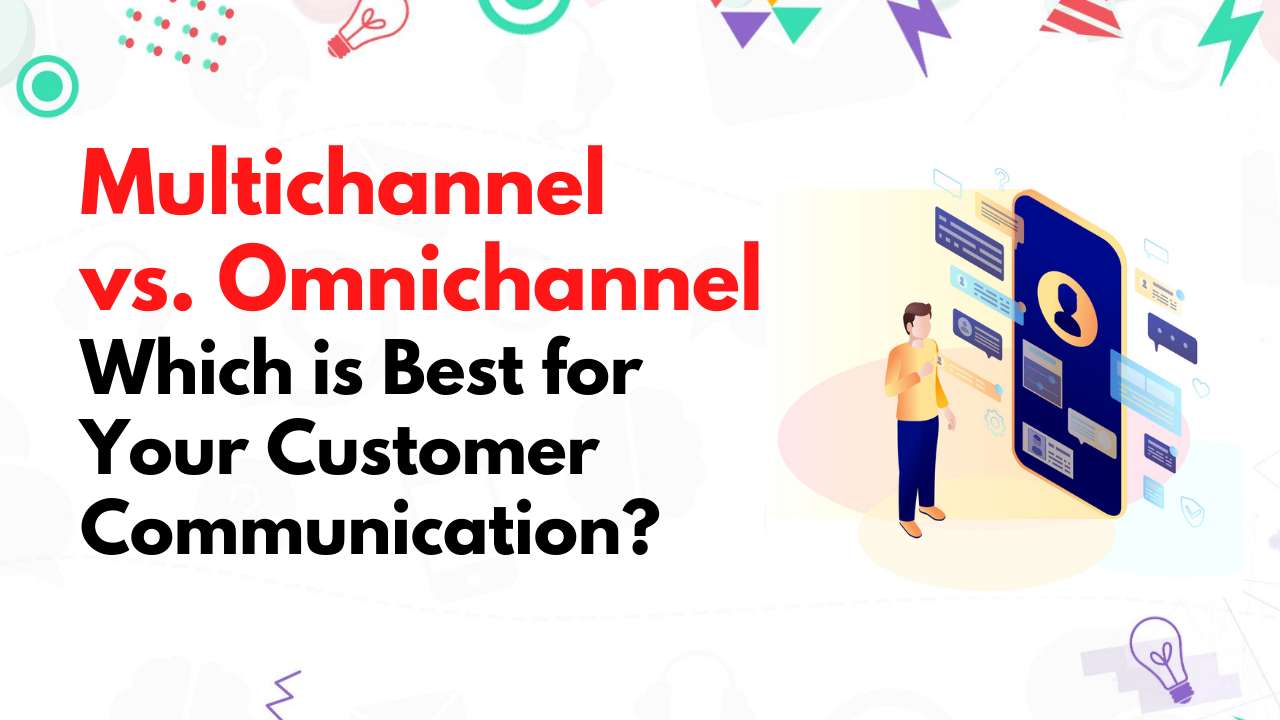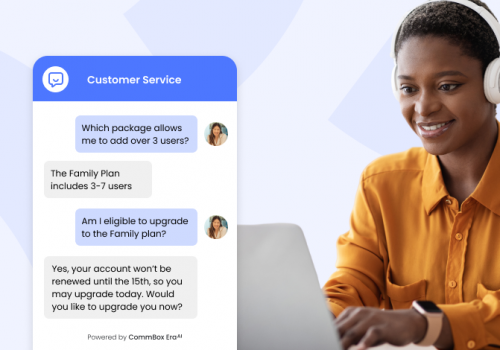Multichannel vs. Omnichannel. Customer communication is the backbone of every enterprise that’s on its growth path. Luckily though, technology has enabled businesses to communicate with their customers efficiently. Nowadays, there are many ways of establishing communication channels.
Global businesses are using multichannel and omnichannel approaches to communicate with their customers. They are bridging the gap between brands and customers by solving communication challenges in retail or any other industry.
However, some practices are better than others. Keep reading to see what’s the better approach, multichannel or omnichannel communication.
What is multichannel customer communication?
Multichannel customer communication simply means that a business is opening up different communication channels. That allows the customers to reach out to the brand on multiple platforms.
With this approach, companies create a simple way of communicating with their customers. They are capable of providing responsive customer support that provides solutions quickly.
Businesses now offer customer communication via channels such as:
- Live chat
- Social media
- SMS
- Phone
- Viber
- Telegram and many other communication channels.
As technology has moved forward, you can now find other customer communication approaches.
What is omnichannel customer communication?

Omnichannel customer communication also uses a multitude of communication channels.
However, there’s a vital difference. All the communication channels integrate to form a single system. That way, all the communication points are recorded and customers can continue where they’ve left off.
To clarify, a customer can reach out to the support center via Facebook but continue communication via video call. The video call operator will then have all the details about the contact that occurred on Facebook before.
The omnichannel approach serves to deliver effective customer communication. For example, using tools such as Handwrytten is a great way to start communication in a unique way. But combining it with the rest of your communication channels makes it even more powerful.
You can easily create a communication experience that’s unique for your brand. It’s a great way to leave a memorable first impression.
What are the core differences?
There are three primary differences between the multichannel and omnichannel communication approaches. They are:
- Customer angle
- System complexity
- Cost
Let’s explore each of these in more detail.
Customer angle
Both communication approaches serve to build relationships between businesses and customers.
A multichannel system will allow you to build higher customer engagement and focus on getting more channels. It’s a great way to communicate with your customers, but it might not be the most optimal since it lacks a particular focus on their experience.
With an omnichannel approach, however, you’ll focus on providing outstanding customer service. The system comes with features that you can use to create a holistic journey that integrates all channels into a single system.
For example, your customers can jump from one device to another and continue communication when chatting with your support. Plus, you get to deliver personalized experiences that your customers will enjoy.
System complexity
Omnichannel systems are a bit more complicated. They require a strategy and following the best approaches to maximize effectiveness. You’ll need to figure out which tools work together and how you should integrate them. On top of that, you’ll need to focus on educating your employees.
Everyone in your business will need to understand how customer communication works and their role in the whole process.
For example, an employee who needs to forward the customer to another team member needs to share all the relevant information in the company’s CRM solution. The next employee can see the customer’s request details with the previous agent and immediately resolve the issue.
The omnichannel approach is ineffective without a strategy and employees who don’t know which processes to follow.
On the other hand, the multichannel approach is easy to set up. Your marketing and customer support teams open up different channels of communication. Then, they address customers’ needs and build stronger relationships with clients.
Cost
More complexity means more expenses. Omnichannel communication will require more investment in employee training and picking the right software tools. However, as customer satisfaction keeps growing, so will customer retention.
In the end, relying on omnichannel customer communication comes with a great ROI. Making the initial investment will likely pay off in the long run.
Multichannel vs. omnichannel: Which is better for customer communication?

Find out more about the CommBox smart customer communication solution
Keeping your customer communication smooth is essential for achieving high customer satisfaction. It’s one of the best strategies to keep customer retention high. You can use both of these approaches to achieve that goal.
However, one will consistently outperform the other, given how feature-rich it is. A couple of reasons are:
- Customer service quality
- Focus on the client
- Customer journey
Omnichannel outshines the multichannel approach in all three aspects, as can be seen in the retail industry. Here’s how.
1. Customer service quality
Customer service quality is the most significant point where these approaches differentiate.
The focus of multichannel communication is opening as many channels of communication as possible. However, the quality of your service isn’t as prioritized.
Of course, it’s still a great customer support approach, but the moment an issue needs to go to another customer support agent, things become more difficult. The problem is that the customer now has to repeat their issue to another customer support agent.
That ruins the flow of the whole process as frustration starts building up.
An omnichannel approach focuses on the quality of the service by enabling smooth transitions from one communication channel to another. While you won’t find countless customer support contact options, you’ll find that those available are integrated to perform when needed flawlessly.
Unifying customer service becomes a much smaller challenge with the omnichannel approach. For example, those reaching out from their smartphones should be able to switch to a desktop if necessary quickly. That’s where following modern UI design trends helps.
2. Complete focus on client
With a multichannel approach, businesses often get caught up with maximizing the number of communication channels. They also focus on growing the channels’ follower numbers rather than improving the customers’ experiences.
If one of the channels is Facebook, the focus quickly shifts towards generating more followers and likes. That helps business growth and improves marketing efforts. However, the focus is on the business, not the customer.
The omnichannel approach emphasizes the customer. Whether we’re talking about email marketing, live chat customer support, or a phone call, the client is at the center of the omnichannel system.
3. Impeccable customer journey
Omnichannel communication heavily focuses on the customer journey. Businesses relying on this approach have multiple communication channels open, but they focus on building bridges across them. The goal is to enable a seamless transfer from one channel to another.
For example, a customer reaching out via live chat needs assistance with reclaiming their account. This type of request is best handled via phone. The live chat agent can quickly forward the client to the phone operator. Then they can take down all the notes about the case and share them on the CRM platform.
Once another customer agent takes the call, he can see all the details about the query and immediately solve the issue. There’s no need for the customer to repeat what the problem is and lose time.
Your customers will notice the level of your brand’s professionalism and stay with your brand as they can count on you to act quickly and help out.
Concluding thoughts
Both of these customer communication approaches are effective ways of building relationships with your customers.
However, if you’re looking for a way to provide the best customer journey and unify your communication efforts, omnichannel is the way to go.
It’s important to note, though, that not all businesses have the budget to implement omnichannel communication. If you belong to that group, starting with a multichannel approach is more than enough to communicate with your customers effectively.
As time passes and the business grows, switching to an omnichannel approach will provide more room for growth as you build a massive community behind your brand.
About Commbox
Commbox is an AI-powered omnichannel customer communication platform. Commbox offers an innovative solution for customer interactions, creating a holistic customer communication experience. Using the Commbox platform, companies and enterprises can automate recurring tasks that are excessively time-consuming, allowing your agents to focus on more important tasks. Commbox paves the way for autonomous business communication without losing the quintessential human touch.
Commbox’s mission is to pave the way for companies worldwide to become autonomous enterprises, without losing their quintessential human touch.
















